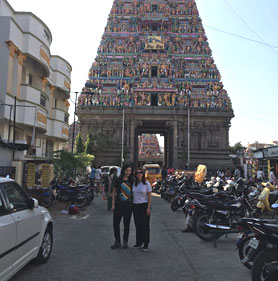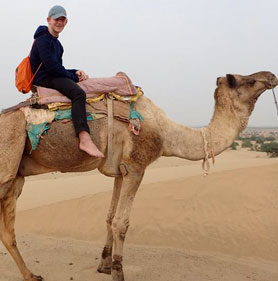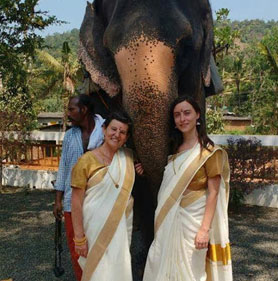Reptiles in Indien
List of Reptiles in Indien
The reptile species is well represented in the country of India. Infact, the subcontinent is home to as many as 447 species of reptiles (census 1994). One can find crocodile inhabiting the rivers, swamps and lakes of India. Then, there is its cousin, known as gharial, which is found in a number of Indian rivers, including Ganges and Brahmaputra. Also included in the list of Indian reptiles are turtles, tortoise and chameleons. The reptiles of India constitute 6.2 percent of the total population of reptiles in Indien. Out of these, 26 species have been listed as threatened in the IUCN Red List of Threatened Animals (IUCN 2006). In the following lines, we have provided more information about the Indian reptiles:
| Die beliebtesten Touren in Indien | Anzahl der Tage | Startpreis* |
|---|---|---|
| Kerala Ayurveda und Yoga Tour | 12 Tage | 1210 Euros |
| Das Beste von Rajasthan | 15 Tage | 815 Euros |
| Das Beste aus Nordindien | 13 Tage | 820 Euros |
| Das Beste aus Nordindien und Nepal | 15 Tage | 956 Euros |
| Taj Mahal Tour ab Delhi | 6 Tage | 328 Euros |
|
Chameleon |
|
Alligator - Gharial |
|
Crocodile - Mugger |
|
Tortoise |
|
Turtle |
|
Water Monitor |
 There is only one species of chameleons found in the Indian subcontinent, scientifically known as Chamaeleo zeylanicus. The term 'chameleon' is a combination of two Greek words, 'Chamai', meaning 'on the ground/earth' and Leon, meaning 'lion'. Thus, 'chameleon' means 'earth lion'. The foot structure, eyes and tongue of all the chameleons are the same.
There is only one species of chameleons found in the Indian subcontinent, scientifically known as Chamaeleo zeylanicus. The term 'chameleon' is a combination of two Greek words, 'Chamai', meaning 'on the ground/earth' and Leon, meaning 'lion'. Thus, 'chameleon' means 'earth lion'. The foot structure, eyes and tongue of all the chameleons are the same. Gharial crocodile counts amongst the largest crocodile species in the world. It is also one of two surviving members of the Gavialidae family. Ghavial Crocodiles of India have an elongated and narrow snout, which becomes thinner with age. There is a bulbous growth on the tip of an adult male's snout, known as 'ghara'. The length of a Gharial crocodile is somewhere around 5 to 6 meters. It has long and narrow jaws, which are razor-sharp.
Gharial crocodile counts amongst the largest crocodile species in the world. It is also one of two surviving members of the Gavialidae family. Ghavial Crocodiles of India have an elongated and narrow snout, which becomes thinner with age. There is a bulbous growth on the tip of an adult male's snout, known as 'ghara'. The length of a Gharial crocodile is somewhere around 5 to 6 meters. It has long and narrow jaws, which are razor-sharp. Mugger crocodile belongs to the Crocodylidae Family and is scientifically known as Crocodylus palustris. Adult Mugger crocodiles of India are bright olive in color, while the young ones are on the paler side. The entire body is spotted with black and scaled. Outer toes as well as fingers are webbed at the base.
Mugger crocodile belongs to the Crocodylidae Family and is scientifically known as Crocodylus palustris. Adult Mugger crocodiles of India are bright olive in color, while the young ones are on the paler side. The entire body is spotted with black and scaled. Outer toes as well as fingers are webbed at the base. Indian tortoise belongs to the Testudines Order and, like turtles, has a shell as its protective covering. It has both an endoskeleton as well as an exoskeleton. The length of a tortoise varies between a few centimeters and two meters. Infact, the growth of a tortoise depends upon the amount of food and water it eats. On an abundant supply of food, it may grow to quite a large size.
Indian tortoise belongs to the Testudines Order and, like turtles, has a shell as its protective covering. It has both an endoskeleton as well as an exoskeleton. The length of a tortoise varies between a few centimeters and two meters. Infact, the growth of a tortoise depends upon the amount of food and water it eats. On an abundant supply of food, it may grow to quite a large size. Indian turtle, along with tortoise and terrapin, belongs to the Testudines order of reptiles and the Chelonia crown group. The body of a turtle is covered with special bony or cartilaginous shell, which is developed from its ribs. One of the oldest reptile groups, the turtle of India was in existence even before lizards and snakes. Some of the species of the Indian turtles have become extinct, while a number of others have become highly endangered. Turtles are cold-blooded creatures i.e., their body temperature changes with their surroundings. The size of an Indian turtle tends to vary a lot, with marine turtles being bigger than land and freshwater ones.
Indian turtle, along with tortoise and terrapin, belongs to the Testudines order of reptiles and the Chelonia crown group. The body of a turtle is covered with special bony or cartilaginous shell, which is developed from its ribs. One of the oldest reptile groups, the turtle of India was in existence even before lizards and snakes. Some of the species of the Indian turtles have become extinct, while a number of others have become highly endangered. Turtles are cold-blooded creatures i.e., their body temperature changes with their surroundings. The size of an Indian turtle tends to vary a lot, with marine turtles being bigger than land and freshwater ones. Indian Water Monitor lizard is one of the largest as well as the heaviest species of lizards, second only to the Komodo Monitors. The average length of a water monitor is around 4 feet. Its entire upper body has round and protruding scales and the abdomen is covered with smooth scales. Usually drab gray or olive in color, Water monitors of India are dotted with circular-shaped yellow spots. The tail is quite long, making 1/3rd of the total length. Their claws are very sharp and the sense of smell is highly developed.
Indian Water Monitor lizard is one of the largest as well as the heaviest species of lizards, second only to the Komodo Monitors. The average length of a water monitor is around 4 feet. Its entire upper body has round and protruding scales and the abdomen is covered with smooth scales. Usually drab gray or olive in color, Water monitors of India are dotted with circular-shaped yellow spots. The tail is quite long, making 1/3rd of the total length. Their claws are very sharp and the sense of smell is highly developed.





